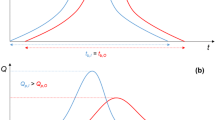Abstract
The upgrade of the hydrological safety of dams is a critical issue to avoid failures that can dramatically affect people and assets. This paper shows a numerical methodology to analyse the safety of the Belesar dam (NW, Spain) based on two different numerical codes. First, a mesh-based code named Iber, suited to deal with large 2-D domains, is used to simulate the impoundment. The initial conditions and the inlet provided to Iber correspond to the maximum water elevation and the maximum expected inflow to the impoundment defined in the technical specifications of the dam, which are associated to the more hazardous operation conditions of the dam. Iber provides information about the time needed for water to attain the crest of the dam when floodgates are closed. In addition, it also provides the velocity of discharge when gates are opened. Then, a mesh-free code named DualSPHysics, which is especially suited to deal with complex and violent 3-D flows, is used to reproduce the behaviour of one of the spillways of the dam starting from the results obtained with Iber, which are used as inlet conditions for DualSPHysics. The combined results of both model show that the left spillway can discharge the surplus of water associated to the maximum inflow to the reservoir if the gates of the spillways are opened before the overtopping of the dam was observed. In addition, water depth measured on the spillway is considerably lower than the lateral walls, preventing overtopping. Finally, velocities at different points of the spillway showed to be in good agreement with theoretical values.
Similar content being viewed by others
References
De Michele C., Salvadori G., Canossi M. et al. Bivariate statistical approach to check adequacy of dam spillway [J]. Journal of Hydrologic Engineering, 2005, 10(1): 50–57.
Tung Y. K. Some recent progress im uncertainty analysis for hydraulic design [R]. Laramie, USA: University of Wyoming, 1993.
Brown C. A., Graham W. J. Assessing the threat to life from dam failure [J]. Journal of the American Water Resources Association, 1988, 24(6): 1303–1309.
Betamio de Almeida A., Viseu T. Dams and valleys safety: A present and future challenge [C]. Proceedings of the International NATO Workshop on Dams Safety Management at Downstream Valleys, Lisbon, Portugal, 1996.
Bladé E., Cea L., Corestein G. et al. Iber: Herramienta de simulación numérica del flujo en ríos [J]. Revista Internacional de Métodos Numéricos para Cálculo y Diseño en Ingeniería, 2014, 30(1): 1–10.
Crespo A. J. C., Domínguez J. M., Rogers B. D. et al. DualSPHysics: Open-source parallel CFD solver on SPH [J]. Computer Physics Communications, 2015, 187: 204–216.
Bonasia R., Areu-Rangel O. S., Tolentino D. et al. Flooding hazard assessment at Tulancingo (Hidalgo, Mexico) [J]. Journal of Flood Risk Management, 2017, https://doi.org/10.1111/jfr3.12312.
Areu-Rangel O. S., González-Cao J., Crespo A. J. C. et al. Numerical modelling of hydrological safety assignement in dams with IBER [J]. Sustainable Water Resources Management, 2017, (4): 1–12.
Altomare C., Crespo A. J. C., Rogers B. D. et al. Numerical modelling of armour block sea breakwater with smoothed particle hydrodinamics [J]. Computers ans Structures, 2014, 130(1): 34–45.
Altomare C., Crespo A. J. C., Domíguez J. M. et al. Applicability of smoothed particle hydrodinamics for estimation of sea wave impact on coastal structures [J]. Coastal Engineering, 2015, 96: 1–12.
Barreiro A., Domínguez J. M., Crespo A. J. C. et al. Integration of UAV photogrammetry and SPH modelling of fluids to study runoff on real terrains [J]. PLos One, 2014, 9(11): e111031.
QGIS Development Team. QGIS geographic information system [R]. Open Source Geospatial Foundation Project, 2016.
Blender. https: www.blender.org [EB/OL]. 2017.
González-Cao J., García-Feal O., Crespo A. J. C. et al. Predicción de inundaciones originadas por precipitaciones extremas mediante el módulo hidrológico de Iber [C]. V Jornadas de Ingeniería del Agua, La Coruña, Spain, 2017.
Domínguez J. M., Crespo A. J. C. et al. New multi-GPU implementation for smoothed particle hydrodynamics on heterogeneous clusters [J]. Computer Physics Communications, 2013, 184(8): 1848–1860.
Altomare C., Domínguez J. M., Crespo A. J. C. et al. Longcrested wave generation and absorption for SPH-based DualSPHysics model [J]. Coastal Engineering, 2017, 127: 37–54.
Canelas R. B., Crespo A. J. C., Domínguez J. M. et al. SPH-DCDEM model for arbitrary geometries in free surface solid-fluid flows [J]. Computer Physics Communications, 2016, 202: 131–140.
Crespo A. J. C., Gómez-Gesteira M., Dalrymple R. A. Boundary conditions generated by dynamic particles in SPH methods [J]. Computers, Materials and Continua,2007, 5(3): 173–184.
Tafuni A., Dominguez J. M., Vacondio R. et al. Accurate and efficient SPH open boundary conditions for real 3-D engineering problems [C]. 12th International SPHERIC workshop, Orense, Spain, 2017.
Husain S. M., Muhammed J. R., Karunarathna H. U. et al. Investigation of pressure variations over stepped spillways using smooth particle hydrodinamics [J]. Advances in Water Resources, 2014, 66(2): 52–69.
Bureau of Reclamations. Design of small dams [M]. Third Edition, Denver, Colorado, USA: Bureau of Reclamations, 1987.
Acknowledgements
This work is partially supported under projects IMDROFLOOD (Water JPI-WaterWorks 2014), Programa de Consolidation e Estructuracion de Unidades de Investigation Competitivas (ED431C 2017/ 64) and Risc ML (Interreg Program, European Regional Development Fund, ERDF). One of the authors, A. J. C. C., is funded by a Ramon y Cajal grant of the Ministerio de Economia y Competitividad del Gobierno de Espana (RYC-2013-12617). One of us, J. G. C., wants to acknowledge Dr. Luis Cea for helpful discussions.
Author information
Authors and Affiliations
Corresponding author
Rights and permissions
About this article
Cite this article
González-Cao, J., García-Feal, O., Domínguez, J.M. et al. Analysis of the hydrological safety of dams combining two numerical tools: Iber and DualSPHysics. J Hydrodyn 30, 87–94 (2018). https://doi.org/10.1007/s42241-018-0009-6
Received:
Accepted:
Published:
Issue Date:
DOI: https://doi.org/10.1007/s42241-018-0009-6




